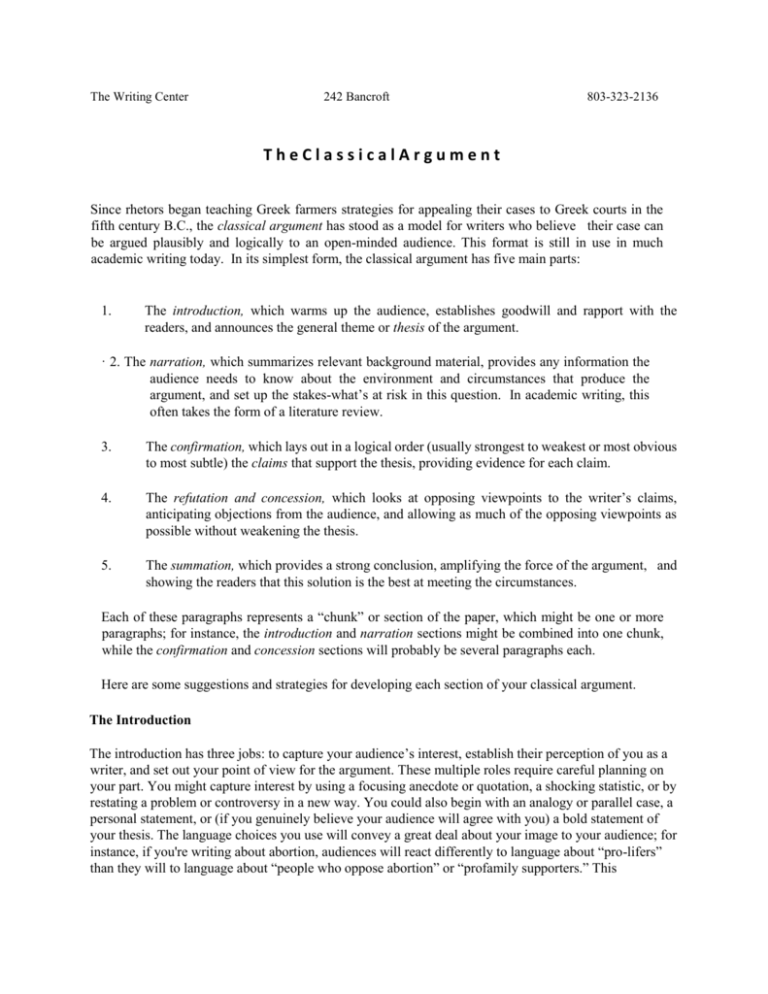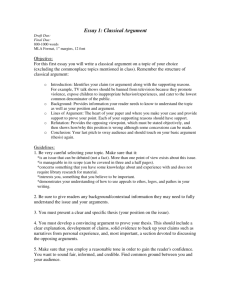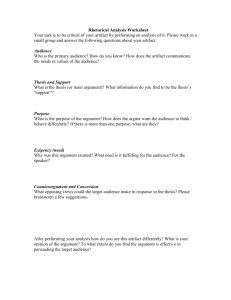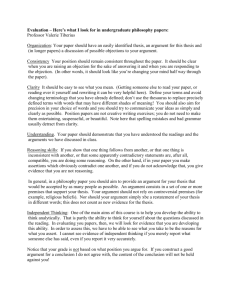centerHandoutClassicalArgument BLOG
advertisement

The Writing Center 242 Bancroft 803-323-2136 TheClassicalArgument Since rhetors began teaching Greek farmers strategies for appealing their cases to Greek courts in the fifth century B.C., the classical argument has stood as a model for writers who believe their case can be argued plausibly and logically to an open-minded audience. This format is still in use in much academic writing today. In its simplest form, the classical argument has five main parts: 1. The introduction, which warms up the audience, establishes goodwill and rapport with the readers, and announces the general theme or thesis of the argument. · 2. The narration, which summarizes relevant background material, provides any information the audience needs to know about the environment and circumstances that produce the argument, and set up the stakes-what’s at risk in this question. In academic writing, this often takes the form of a literature review. 3. The confirmation, which lays out in a logical order (usually strongest to weakest or most obvious to most subtle) the claims that support the thesis, providing evidence for each claim. 4. The refutation and concession, which looks at opposing viewpoints to the writer’s claims, anticipating objections from the audience, and allowing as much of the opposing viewpoints as possible without weakening the thesis. 5. The summation, which provides a strong conclusion, amplifying the force of the argument, and showing the readers that this solution is the best at meeting the circumstances. Each of these paragraphs represents a “chunk” or section of the paper, which might be one or more paragraphs; for instance, the introduction and narration sections might be combined into one chunk, while the confirmation and concession sections will probably be several paragraphs each. Here are some suggestions and strategies for developing each section of your classical argument. The Introduction The introduction has three jobs: to capture your audience’s interest, establish their perception of you as a writer, and set out your point of view for the argument. These multiple roles require careful planning on your part. You might capture interest by using a focusing anecdote or quotation, a shocking statistic, or by restating a problem or controversy in a new way. You could also begin with an analogy or parallel case, a personal statement, or (if you genuinely believe your audience will agree with you) a bold statement of your thesis. The language choices you use will convey a great deal about your image to your audience; for instance, if you're writing about abortion, audiences will react differently to language about “pro-lifers” than they will to language about “people who oppose abortion” or “profamily supporters.” This introduction usually funnels down into a solid, clear thesis statement; if you can’t find a sentence in this section that explicitly says what point you are supporting, you need to keep refining the introduction. The Narration In the narration, you want to establish a context for your argument. This means that you need to explain the situation to which your argument is responding, as well as any relevant background information, history, statistics, and so on that affect it. (For instance, the abortion argument might well mention Roe vs. Wade, more recent cases, legal precedents, and even public opinion polls.) Once again, the language with which you describe this background will give the audience a picture of you, so choose it carefully. By the end of this section, the readers should understand what’s at stake in this argument—the issues and alternatives the community faces—so that they can evaluate your claims fairly. The Confirmation This section allows you to explain why you believe in your thesis. It takes up several supporting claims individually, so that you can develop each one by bringing in facts, examples, testimony, definitions, and so on. It's important that you explain why the evidence for each claim supports it and the larger thesis; this builds a chain of reasoning in support of your argument. The Refutation and Concession This is sometimes a hard section for writers to develop; who wants to think of the reasons why an argument won’t work? But this can often be the strongest part of an argument, for when you show your audience that you have anticipated their potential objections, and have an answer for them, you defuse the audience’s ability to oppose you and persuade them to accept your point of view. If there are places where you agree with the opposition, conceding their points creates goodwill and respect without weakening your thesis. For instance, if you are supporting parental notification for abortions, you might concede that there are times when girls shouldn’t be expected to get their parents’ permission, such as in abuse or incest cases. But then you might suggest that a court-appointed counselor give permission instead so that the young girl gets an adult’s support in making this decision. The Conclusion It is tempting in the conclusion just to restate the claims and thesis, but this does not give a sense of .momentum or closure to your argument. Instead, try to hearken back to the narration and the issues. Remind your readers what’s at stake and try to show why your thesis provides the best solution to the issue being faced. This gives an impression of the rightness and importance of your argument, and suggests its larger significance or long-range impact. More importantly, it gives the readers a psychological sense of closure; the argument winds up instead of breaking off. More readings on classical argument: Edward P. J. Corbett, Classical Rhetoric for the Modern Student (Oxford, 1971) Walter H. Beale, Real Writing (Scott Foresman, 1986)








